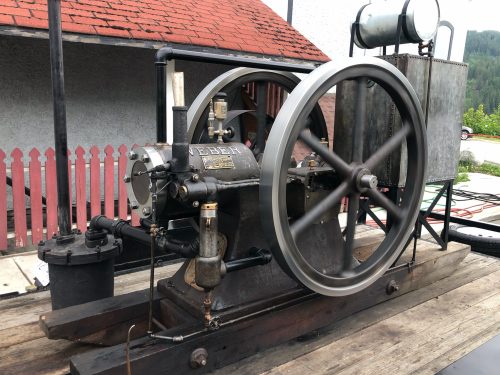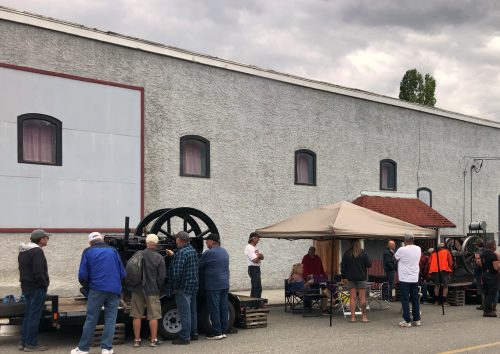The big wheels that run the pistons on Jordan Meeker’s 127-year-old, four-cycle, hot tube ignited gasoline engine stick out at car shows.
The Weber engine looks like a relic from the steampunk era. The big wheels turn and as the engine fires every few seconds, puffs of smoke emit from the vertical exhaust pipe.

Old engines like this were used to haul waste out of the mines high in the mountains in the West Kootenays. Photo by Meagan Deuling.
Meeker, 61, known as the Slocan Kid, is an electrician by trade. But collecting is his passion. He started hauling old engines out of mine sites high in the West Kootenay mountains in the ‘80s. “Every day I’m not working I’m up in the bush,” he said.
Prospectors flooded to the West Kootenays in the 1890s when silver was discovered. Meeker has been to every big mine in what he calls the triangle — between Kaslo, New Denver and Nelson, and most of the small mines. He goes up mountains in the Ymir region, and Lardeau.
Along with silver, lead and zinc were also mined in the region.
“That’s why we’re here, that’s why this town exists,” Meeker says of Kaslo. “This is all mining country and Kaslo was a major centre for getting into the silver rush at Sandon and that area.”
The engines were used to haul waste from mines. Meeker figures the one he brings to car shows was abandoned in 1902. He found it scattered in pieces, half buried in a tailings pile.
The mines aren’t easy to find. They’re usually at about 7000 feet of elevation, there aren’t any roads to them as mules were used to haul in heavy equipment like the engines in 300 pound pieces. But the tough access is what has preserved the engines—if the mines were easy to get to Meeker says the engines would have been scraped down long ago.

Meeker documented the discovery and restoration of the engine that he brings to car shows. Photo by Meagan Deuling.
“I’ve got several super rare engines that were all at high elevation,” he says, “and then we drag ‘em out by hand piece by piece.”
Once he has money saved up for the restoration, it only takes a few months for him to get the engines running.
“To bring it back to life is a really great thing—the first exhaust, it’s like heaven, it’s like perfume!” he said. Once you fire up an engine that’s been dead for 100 years—“It’s a joy,” he said. “Now you need another.”
It costs Meeker about $10,000 or more to restore the engines. He doesn’t do it for the money, he says. But when people tell him he needs to keep the engines in the West Kootenays because they’re local history, he notices that no one steps up to the plate to help fund it. ‘Have an auction, send it down to an auction house in the States.’” Meeker said.
Unlike Canadian collectors, he says Americans are serious and are willing to pay up to $30,000 for the rare engines in his possession, of which he has “several.”
Meeker started digging for old glass bottles when he was a teen on the coast near Vancouver. He used to read books about the Kootenays, and when he was 18 he got a job with CP Rail. He arrived in Nelson for the first time in ’81 and it blew his mind. He immediately found his way up to a mine above Nelson, and a few years later he found his first engine.
Along with engines he collects iron, cast iron and blacksmith artefacts, photographs, documents and maps.
He’s got a collection that tells stories of the first people who settled in the West Kootenays, and an urge to find more.

A crowd gathers around two old engines at the Kaslo car show. Photo by Meagan Deuling.
The problem with the joy of smelling the first exhaust in an old engine, is that it means he has to find another.
With that in mind, he has a few mines he’s getting ready to hike up to this summer to see what he can find.
“What else are you going to do?” He said. “You can’t leave it there.”
Click below for a radio report on this story:


